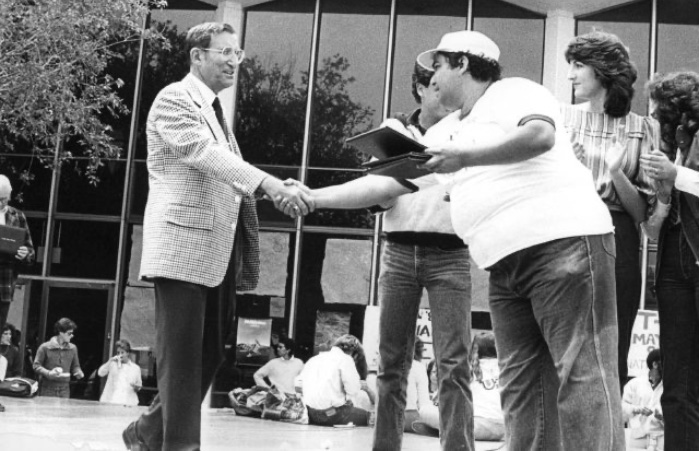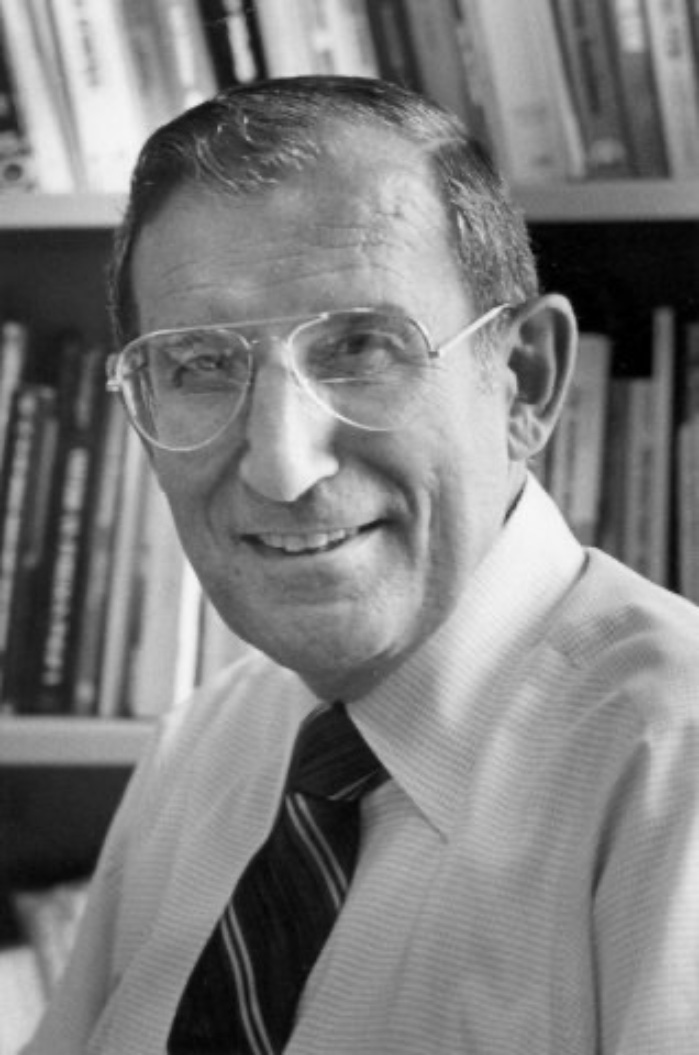Allan R. Brown (CSM Class of 1954)
Professor of political science; CSM dean of students and vice president
Astute and trusted listener to all persons during 1968 Uprising
CSM’s top student service award honors his legacy
When incoming CSM President Robert Ewigleben needed an administrator during the student unrest of the 1960s, he chose a college political scientist whom students loved for his focus on their concerns.
That professor, Allan R. Brown, took the promotion on one unusual condition: He insisted on continuing to teach one class each semester. CSM’s social science faculty had to approve this, and there was dissent.
“If you don’t let this man teach one course,” CSM history Professor Rudy Lapp told his colleagues, “it will be wrong.”
So Brown (1922–2000) continuously taught Political Science I while rising in CSM’s administration until his retirement as vice president in 1989.
In 1968, the year of CSM’s student uprising, Brown was voted most outstanding instructor in a campus-wide poll conducted by the student newspaper. One of CSM’s top honors, the Allan R. Brown Outstanding Student Service and Leadership Award, pays tribute to his gifts.
Brown was a veteran, an Air Force Reserve officer and a political liberal. He was a World War II bombardier shot down over Germany who later served in Korea. He was a CSM alumnus and a Stanford PhD; a speaker of several languages and a passionate defender of young people’s free speech. He waded into the toughest campus issues with complete aplomb.
“To the student body, he was very outstanding,” recalled 1989 Associated Students president Karl Ferguson, who gave the inaugural award that year at Commencement. “I was impressed enough that he had to be honored in a great way.”
Brown grew up “impoverished” in the Bronx, New York, his wife, Kathy, said in a 2016 oral history. During World War II, he enlisted in what was then the Army Air Corps and eventually assigned to the 8th Air Force, 14th Combat Wing, 392nd Bomb Squadron in England.
He told the story of his capture to his 13-year-old neighbor, Peter Sparacino, for a seventh-grade class paper now preserved in the San Mateo County History Museum.


Allan Brown in the 1970s. SMCCD Historical Photo Archive
“On a mission over Munich, Mr. Brown’s bomber was hit by flak which locked the elevators,” Sparacino wrote.” Five to 10 German fighters intercepted him and shredded the plane with their guns. The Liberator went up in flames. Three airmen were burned inside the bomber, while one died on the ground.”
Brown was the only survivor.
“The civilians that captured Mr. Brown called a Luftwaffe officer to pick him up, who then took him to solitary confinement. German interrogation officers charged Mr. Brown as a spy, declaring that he had been dropped in for espionage work. He was driven to the cold regions of the Baltic Sea to Stalag Luftwaffe I, a prison camp for airmen, where he remained until his liberation by Soviet troops on May 18, 1945.”
In 1952, Brown enrolled at CSM in political science and graduated two years later. He transferred to Stanford, where he went on to a PhD in Japanese postwar politics. As a major in the 9366th Air Reserve Squadron in Burlingame, he taught management to junior officers. Around 1960, he began teaching at CSM’s Coyote Point campus.
In 1962, Brown publicly supported the Junior Statesman Club of San Carlos High School and “freedom of inquiry in controversial issues” for backing “equal rights for the Communist Party, legalized birth control and abolition of the House Un-American Affairs Committee.” San Carlos’s principal and superintendent were under fire from parents for allowing the students’ debate.
Brown led CSM’s Model United Nations, a nonprofit that advances understanding of global issues through experiential learning. Kathy Brown, Class of 1964, took courses from him and years later helped with the Model UN, which became the springboard to their romance and marriage.
She believes Allan’s patience stemmed from his wartime experiences.
“Allan had a reputation for being very deliberative in his decision-making,” she said. “He always thought three steps ahead: ‘If we do this, then what?’ The CSM presidents [he served three: Ewigleben, David Mertes and Lois Callahan] relied on his judgment and his expertise.”
His only real aggravation, Kathy said, came from parking complaints.
“The faculty would be screaming about parking, and he would come home and just shake his head. He’d say, ‘It’s such a small item,’ but he had to spend so much time dealing with it.”
On Brown’s retirement in 1989, the Associated Students of College of San Mateo (ASCSM) and college administration established the service award that bears his name. It recognizes students whose volunteer activities outside the classroom demonstrate exceptional leadership, remarkable accomplishment, outstanding character and inspiration to other students.
Read more about the Allan R. Brown Outstanding Student Service and Leadership Award.
Learn about the Allan R. Brown Scholarship established at CSM by Kathy Brown.
See Brown’s Air Force uniform and insignia in the San Mateo County History Museum.

